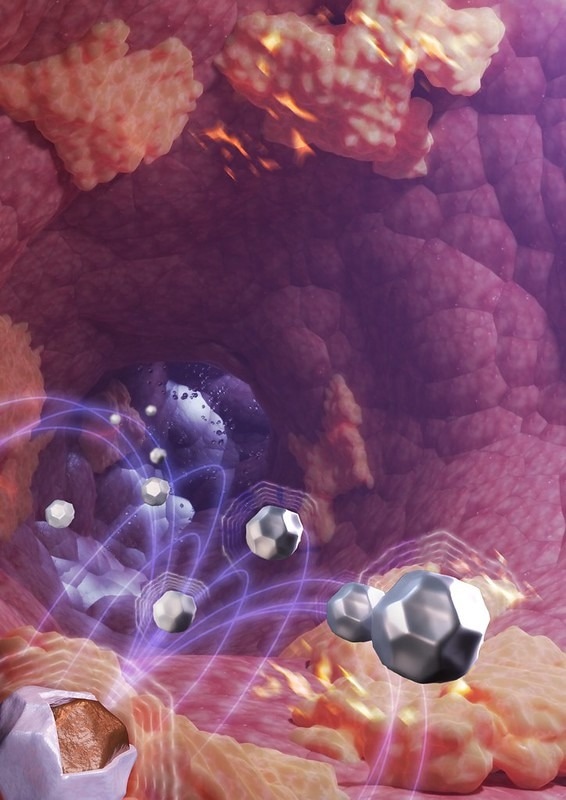Reviewed by Emily Henderson, B.Sc.Nov 16 2022
Scientists from Oregon State University have developed a method for creating magnetic nanoparticles that heat up more quickly than any other nanoparticle before, enhancing their capacity to fight cancer.
 Nanoparticles accumulating in tumor. Image Credit: Oregon State University
Nanoparticles accumulating in tumor. Image Credit: Oregon State University
The development of an advanced thermal decomposition technique for creating nanoparticles capable of reaching temperatures in cancer lesions of up to 50 °C, or 122 ℉, when exposed to an alternating magnetic field was led by faculty from the OSU College of Pharmacy.
The journal Small Methods published the results of the preclinical research directed by Oleh and Olena Taratula.
The scientists claimed that magnetic nanoparticles have demonstrated anti-cancer potential for years. The particles, which are minute bits of matter as small as one billionth of a meter, are subjected to an alternating magnetic field once inside a tumor.
The nanoparticles heat up during non-invasive exposure to the field, weakening or eliminating the cancer cells.
Magnetic hyperthermia shows great promise for the treatment of many types of cancer. Many preclinical and clinical studies have demonstrated its potential to either kill cancer cells directly or enhance their susceptibility to radiation and chemotherapy.
Olena Taratula, Associate Professor, College of Pharmacy, Oregon State University
Oleh Taratula noted that, at the moment, magnetic hypothermia is only effective for patients whose tumors can be reached with a hypodermic needle and not for those with difficult-to-reach cancers like metastatic ovarian cancer.
With currently available magnetic nanoparticles, the required therapeutic temperatures—above 44 degrees Celsius—can only be achieved by direct injection into the tumor.
Oleh Taratula, PhD, Professor, College of Pharmacy, Oregon State University
He added, “The nanoparticles have only moderate heating efficiency, which means you need a high concentration of them in the tumor to generate enough heat. And numerous studies have shown that only a small percentage of systemically injected nanoparticles accumulate in tumors, making it a challenge to get that high concentration.”
To solve those issues, the researchers created more effective magnetic nanoparticles to heat through a new chemical manufacturing process.
They showed in a mouse model that low-dose systemic administration of the cobalt-doped nanoparticles causes them to accumulate in metastatic ovarian cancer tumors and that they can reach a temperature of 50 °C when exposed to an alternating magnetic field.
“To our knowledge, this is the first time it is been shown that magnetic nanoparticles injected intravenously at a clinically recommended dose are capable of increasing the temperature of cancer tissue above 44 degrees Celsius,” Olena Taratula added.
She further stated, “We also demonstrated that our novel method could be used for the synthesis of various core-shell nanoparticles. It could serve as a foundation for the development of novel nanoparticles with high heating performance, further advancing systemic magnetic hyperthermia for treating cancer.”
According to her, core-shell nanoparticles have an inner core structure and an outer shell made of various materials. Due to the unusual properties that can be produced by the combination of core and shell material, geometry, and design, researchers are particularly interested in them.
Researchers from the College of Pharmacy Youngrong Park, Abraham Moses, Peter Do, Ananiya Demessie, Tetiana Korzun, Fahad Sabei, Conroy Sun, Prem Singh, Fahad Sabei, and Hassan Albarqi, along with Pallavi Dhagat from the Oregon State College of Engineering and researchers from Oregon Health & Science University, participated in the collaboration in addition to Olena and Oleh Taratula.
The OSU Advantage Accelerator Innovation Development program, the Eunice Kennedy Shriver National Institute of Child Health and Human Development, and the National Cancer Institute all provided funding for this study.
Journal Reference:
Demessie, A. A., et al. (2022) An Advanced Thermal Decomposition Method to Produce Magnetic Nanoparticles with Ultrahigh Heating Efficiency for Systemic Magnetic Hyperthermia. Small Methods. doi:10.1002/smtd.202200916.